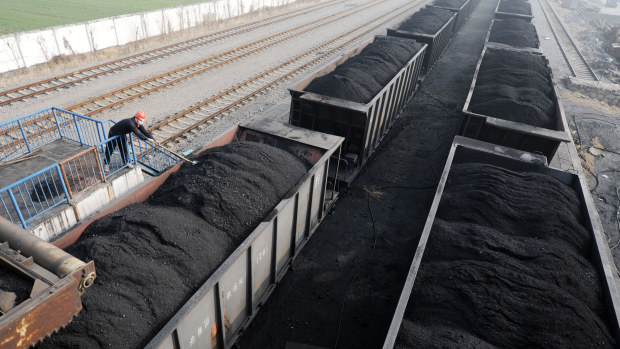Australian coal trickles into China in February

Tokyo | China imported US$42 million ($63 million) worth of Australian coal last month, according to government data, the first confirmation that Beijing has lifted an unofficial ban on the key export.
China customs data for January and February released this week shows 73,982 tonnes of coking coal and 134,254 tonnes of thermal coal were imported from Australia.

Beijing has ended an unofficial ban on Australian coal that has been in force for more than two years. Getty
The total of 207,236 tonnes was a fraction of the 92 million tonnes of coal Australia exported to China in 2019, but analysts said they expected volumes to increase, now that the unofficial ban designed to punish the former Morrison government had been abolished.
Coal imports from Indonesia, Mongolia and Russia overshadowed the volumes from Australia in the same period. The data also shows China is stepping up coal imports from Russia as it seeks to bolster economic ties with Moscow despite Vladimir Putin’s invasion of Ukraine.
The volume of coal from Mongolia imported to China during the first two months of the year increased more than fivefold to more than 8 million tonnes. Russian coal imports also more than doubled to 14.8 million tonnes. Indonesian imports rose 84 per cent to 35 million tonnes.
Last month, S&P Global said three Chinese state-owned power plants – China Datang, China Huaneng Group and China Energy Investment – as well as steel producer China Baowu Steel Group had received permission to import Australian coal. Analysts said there were larger volumes of Australian coal currently on their way to China.
Today Think Tank, a China-based consultancy, said about 2 million tonnes of Australian coal was on its way to China that was not reflected in the current data. Bloomberg said last week that China would allow all domestic companies to import Australian coal.
Australia is the world’s biggest exporter of coking coal with a market share of about 56 per cent.
A resumption in Australian coal exports follows a thawing in bilateral relations since Anthony Albanese met Xi Jinping on the sidelines of the G20 summit in Bali in October.
The Albanese government has asked China to remove sanctions on $20 billion worth of Australian exports, including coal, wine, seafood and other products imposed in 2020. There have been indications China is also easing restrictions on Australian lobsters, cotton and timber.
In January, China imported about 502 tonnes of timber-related products with another 449 tonnes in February, state media reported.
Trade Minister Don Farrell hopes to visit China this year.
China has never formally acknowledged the political bans imposed after the Morrison government called for an inquiry into the origins of COVID-19. Politically motivated sanctions would breach international trading rules.
Last week, China’s Ministry of Commerce declined to confirm whether the coal ban had been lifted, or whether one had been imposed in the first place.
“China implements automatic licensing management for coal imports, and automatic coal import licences can be applied for normally,” a ministry spokeswoman said when asked to confirm if the ban had been lifted.
“What needs to be emphasised is that China manages foreign trade in accordance with WTO rules and Chinese laws and regulations, and it is inappropriate to misinterpret relevant management methods as restrictive measures.”
Subscribe to gift this article
Gift 5 articles to anyone you choose each month when you subscribe.
Subscribe nowAlready a subscriber?
Introducing your Newsfeed
Follow the topics, people and companies that matter to you.
Find out moreRead More
Latest In Asia
Fetching latest articles